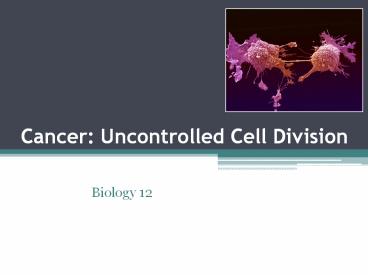Cancer: Uncontrolled Cell Division PowerPoint PPT Presentation
1 / 14
Title: Cancer: Uncontrolled Cell Division
1
Cancer Uncontrolled Cell Division
- Biology 12
2
Some Stats from WHO
- Cancer is a leading cause of death group
worldwide and accounted for 7.4 million deaths
(around 13 of all deaths) in 2004. The main
types of cancer are - Lung (1.3 million deaths/year)
- Stomach (803,000 deaths)
- Colorectal (639,000 deaths)
- Liver (610,000 deaths)
- Breast (519,000 deaths)
3
What is cancer?
- Cancer is a class of diseases characterized by
out-of-control cell growth. - There are over 100 different types of cancer and
each is classified by the type of cell that is
initially affected.
4
What cause cancer at the cellular level?
- Cancer is ultimately the result of cells that
uncontrollably grow and do not die, normal cells
in the body follow an orderly path of growth,
division, and death. - Programmed cell death is called apoptosis, and
when this process breaks down, cancer begins to
form. Unlike regular cells, cancer cells do not
experience programmatic death and instead
continue to grow and divide. This leads to a mass
of abnormal cells that grows out of control.
5
How is a cancer cell different from a normal cell?
- Larger then normal nuclei (and/or multiple
nuclei) - Small cytoplasm
- Can grow in isolation from other cells
- Do not stick to the cells around them
- They may have abnormal numbers and types of
chromosomes caused by mutations
6
(No Transcript)
7
What causes the mutations that lead to cancer?
- Viruses (ex. HPV --gt cervical cancer)
- Bacteria (ex. H. pylori --gt gastric cancer)
- Chemicals (ex. Cigarette smoke --gt lung cancer)
- UV and ionizing radiation (ex. skin cancer)
8
What can happen after a cancer cell forms
- Invasion a cancerous cell manages to move
throughout the body using the blood destroying
healthy tissue in a process - Angiogenesis the cancer cell manages to divide
and new blood vessels grow to supply it with
blood - Metastasis when a tumour successfully spreads
to other parts of the body, grows, invading and
destroying other healthy tissues - Clip showing angiogenesis http//www.medicalnewst
oday.com/info/cancer-oncology/
- Invasion a cancerous cell manages to move
throughout the body using the blood destroying
healthy tissue in a process - Angiogenesis the cancer cell manages to divide
and new blood vessels grow to supply it with
blood - Metastasis when a tumour successfully spreads
to other parts of the body, grows, invading and
destroying other healthy tissues - Clip showing angiogenesis http//www.medicalnewst
oday.com/info/cancer-oncology/
9
How is cancer classified?
- There are five broad groups that are used to
classify cancer. - Carcinomas cells that cover internal and
external parts of the body (ex. lung, breast, and
colon) - Sarcomas cells that are located in bone,
cartilage, fat, connective tissue, muscle, etc. - Lymphomas cancers that begin in the lymph nodes
and immune system. - Leukemias cancers that begin in the bone marrow
and often accumulate in the bloodstream. - Adenomas cancers that arise in the thyroid, the
pituitary gland, the adrenal gland, and other
glandular tissues.
10
How is cancer treated?
- Depends on the type of cancer, the stage of the
cancer (how much it has spread), age, health
status, etc. - Surgery
- Radiation
- Chemotherapy
- Immunotherapy
- Hormone therapy
- Gene therapy
11
Cancer in Plants
- Not exclusive to humans
- Plant galls are abnormal outgrowths of plant
tissues and can be caused by various parasites,
from fungi and bacteria, to insects and mites.
12
Cancer in Dinosaurs too?
- Many dinosaurs had cancer, researchers have
discovered. Their tumours were like those of
human patients, showing that cancer has been
around for a very long time. "Diseases look the
same independent of what critter is affected,"
says radiologist Bruce Rothschild of the North
Eastern Ohio Universities College of Medicine in
Rootstown - http//www.guardian.co.uk/science/2003/oct/23/dino
saurs.science
13
Animation
- http//www.youtube.com/watch?vqxcFbqA7w80
14
To do
- Read page 100-102
- Complete practise questions 1, 2, 3
- Complete Section 3.5 questions 1, 2

